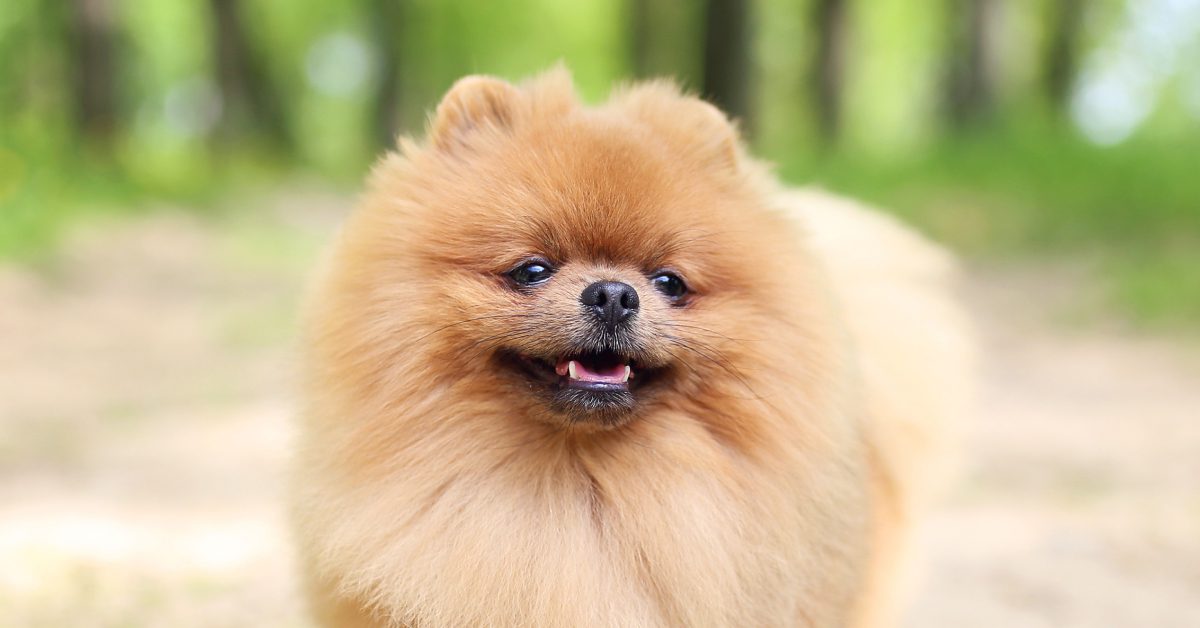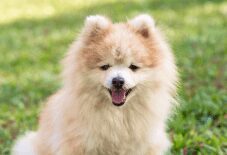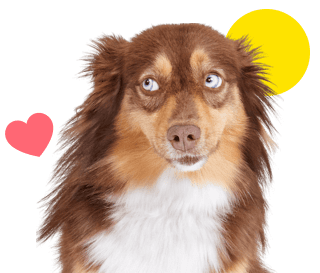
Meet the Pomeranian
High Doggy I.Q.
Protective Pooch
Best Fur Friend
Looking for a big personality in a small package? I’m the pupper for you! I’m smart, highly trainable, and I make a great watchdog (even though I am tiny). I’m very alert and have a loud bark, so I will always let you know what’s up. My size makes me great in an apartment, but your neighbors may not appreciate my loud mouth! I tend to bark at everything, so train me early to hush on command.
I have a confident, big-dog attitude so I sometimes forget that I’m tiny and may challenge bigger dogs. Even though I am super friendly and loving, I’m not the best pupper for small kids who may play rough. I don’t need a ton of exercise, but I love to go on daily walks with my humans (just watch out for me if it’s hot outside). With some short walkies and playtime in the house – I’m especially good at learning tricks and I love to entertain – I will be your happy healthy companion dog furever.
Ready to learn more about me? Let’s dig in.
Ready to learn more about me? Let’s dig in.
 My Many Looks
My Many Looks

Blue Merle

Orange

Cream

Tri-Colored
 My Breed Characteristics
My Breed Characteristics
 Furbulous Fact
Furbulous Fact
We Poms are small but fierce – so much so that two of us actually survived the sinking of the Titanic in 1912! One of the survivors was named Lady, and she boarded a lifeboat with her human, Margaret Hayes. The other Pom (whose name is not known) belonged to the famously wealthy Rothschilds. Mrs. Elizabeth Rothschild refused to board the rescue ship Carpathia without her Pom (however she did board without her husband, Martin, who went down with the ship)!
 As I Grow Up
As I Grow Up
As you can see, we Pomeranians age pretty gracefully. Here are a few key milestones in my growth & development to be aware of as I grow up from a pupper to an adult and senior!

Puppy4 Months
Because I bark at EVERYTHING, it’s impawtant to begin my socialization and obedience training when I’m a pup. (Just make sure I’ve had all my vaccines first, pawlease!)

Adult1 Year
I’m a grownup now, but still getting the hang of being home alone. I might get separation anxiety, so I’ll need a comfy space – a playpen with some toys, light, and background noise is best.

Senior8 Years
I’m almost 50 in dog years! I may be slowing down a bit and developing some arthritis, so make sure I don’t over-exert myself (doggy ramps are super helpful).
 History of My Breed
History of My Breed
If you’re wondering why I have such a big dog attitude in a toy dog body, it’s because we Pomeranians weren’t always small dogs. My ancestors were much bigger and were related to larger Spitz breeds such as Samoyeds, Alaskan Malamutes, and Akitas! Like those breeds, my ancestors were cold-weather sled dogs, which is why we have our thick double coat, plumed tail, and small pointy ears. My breed is named after the Pomerania region of northern Germany and Poland (near the Baltic Sea), and the first Pomeranians weighed around 30 pounds!
My larger ancestors became popular throughout Europe as early as the 16th century, especially in Italy where we were used as watchdogs to guard our humans’ possessions. We were even loyal companion dogs to world-famous musicians and artists, including Michelangelo and Mozart. Pomeranians popularity blew up in England in the 18th century when Queen Charlotte brought two Poms home from Germany in 1767. But Poms as we are today (as the smallest of the Spitz-type dogs) were developed in England when Queen Victoria (Queen Charlotte’s granddaughter) took a liking to us. The Queen fell in love with Poms on a visit to Italy and took some of my ancestors back to Britain where she began to breed us. Queen Victoria’s breeding program is what turned us from medium-sized dogs into the toy breed we are today. It’s also why we now come in over 20 different color combinations – the first Pomeranians were white, black, brown, and parti-colored (one of those colors mixed with white).
My larger ancestors became popular throughout Europe as early as the 16th century, especially in Italy where we were used as watchdogs to guard our humans’ possessions. We were even loyal companion dogs to world-famous musicians and artists, including Michelangelo and Mozart. Pomeranians popularity blew up in England in the 18th century when Queen Charlotte brought two Poms home from Germany in 1767. But Poms as we are today (as the smallest of the Spitz-type dogs) were developed in England when Queen Victoria (Queen Charlotte’s granddaughter) took a liking to us. The Queen fell in love with Poms on a visit to Italy and took some of my ancestors back to Britain where she began to breed us. Queen Victoria’s breeding program is what turned us from medium-sized dogs into the toy breed we are today. It’s also why we now come in over 20 different color combinations – the first Pomeranians were white, black, brown, and parti-colored (one of those colors mixed with white).
 Pawesome Pups to Parent
Pawesome Pups to Parent
In addition to purebred Pomeranians like me, there are tons of pawfectly sweet mixed-breed Poms that are looking to find their furever homes. You can learn where to find your next pet below!



 Care Tips
from Veterinarians
Care Tips
from Veterinarians 
Get X-rays early to detect orthopedic problems.
Pomeranians are prone to knee problems like luxating patellas, and should be evaluated early to prevent arthritis later in their lives. There are different degrees to which they can be affected by this condition, and they may need medication to help prevent ongoing problems. - Michele King, DVM
Monitor your Pomeranian’s heart closely as they age.
Pomeranians may develop heart disease as they get older, so taking your pet for semi-annual examinations is important. This will allow your veterinarian to check for heart murmurs or arrhythmias. - Erica M. Irish, DVM
Routine dental care is key to avoiding gum problems.
Pomeranians are tiny dogs who are prone to periodontal disease, so routine in-home dental care and annual cleanings are a must. - Erica M. Irish, DVM
 Training Tips
from Trainers & Behavior Specialists
Training Tips
from Trainers & Behavior Specialists

Be patient while your Pomeranian is house-training.
Pomeranians are affectionate and are eager to please. They are a joy to train for this reason, and respond quickly to positive reinforcement and praise. These dogs can be difficult to potty train, however, and will need to be worked with consistently during puppyhood and even into adulthood to help teach them where the potty should be used. Beginning early, secure them in a small place like a puppy playpen, and take them outside every couple of hours. Praise them enthusiastically for going potty outside. Repeat this often as you expand the Poms boundaries in your home. - Jen Jones, Certified Dog Trainer

 Why Get Dog Insurance?
from Pumpkin®
Why Get Dog Insurance?
from Pumpkin®
Pomeranians are a generally healthy breed, but ruh-rohs can happen to any dog at any age. If your pup gets hurt or sick, pet insurance can help you say ‘yes’ to the best care, even when it’s costly. When it comes to shopping for this breed, you’ll want to choose insurance plans like Pumpkin's, which can help cover the costs associated with the hereditary conditions Poms are prone to developing. While a reputable breeder will conduct genetic testing on your pup’s parents to help minimize the chances of passing down hereditary conditions – they can’t always be avoided. Let’s look at some common ones, and how Pumpkin Dog Insurance plans could help cover the cost of care!
 Patellar Luxation
Patellar Luxation
Pomeranians are genetically predisposed to patellar luxation, an orthopedic condition where the kneecap (patella) is dislocated from its natural position in the groove of the femur (thigh bone). This condition can greatly affect mobility, and while some cases are mild, others are severe and require corrective surgery.
- Cost to Treat
- $1,500-$3,500 (surgical)
- Pumpkin Pays Back*
- $1,350-$3,150
 Cataracts
Cataracts
Pomeranians are prone to many genetic eye conditions, including cataracts. These opacities that form on the lens of the eye can appear in young adult dogs, or more commonly in aging adults. Depending on the rate of progression, vision impairment may be mild or severe and call for costly surgery.
- Cost to Treat
- $2,600-$3,800 (surgical)
- Pumpkin Pays Back*
- $2,340-$3,420
 Hypothyroidism
Hypothyroidism
Pomeranians are prone to developing Hypothyroidism, which occurs when a dog’s thyroid gland is underactive. This slows down their metabolism, which negatively affects all major organ functions. This condition can be treated (but not cured) with thyroid replacement hormone therapy for the remainder of a Pom’s life.
- Cost to Treat
- $300-$5,000
- Pumpkin Pays Back*
- $270-$4,500
 Collapsing Trachea
Collapsing Trachea
This condition is common in adult toy breeds, and develops when the cartilage rings forming the trachea (windpipe) collapse – causing a honking cough and difficulty breathing. While mild cases are often managed medicinally, severe ones require the placement of tracheal stents, which is a costly surgical procedure.
- Cost to Treat
- $4,500-$5,500 (surgical)
- Pumpkin Pays Back*
- $4,050-$4,950
*Example illustrates reimbursement of a covered vet bill at a 90% reimbursement rate, where the annual deductible had already been satisfied and the annual limit had not yet been met. Coverage and reimbursement results vary based on policy options.

